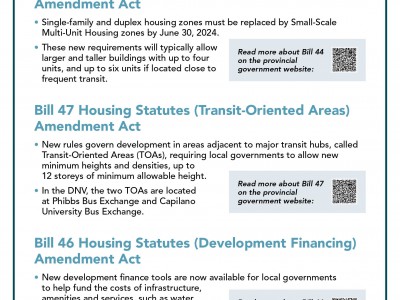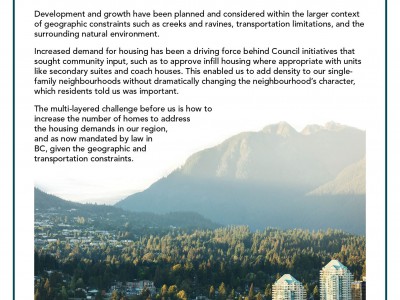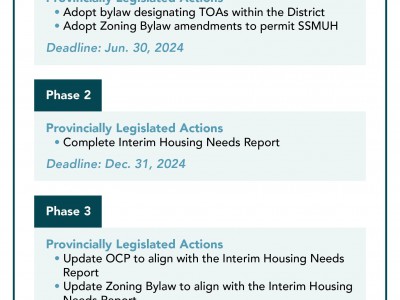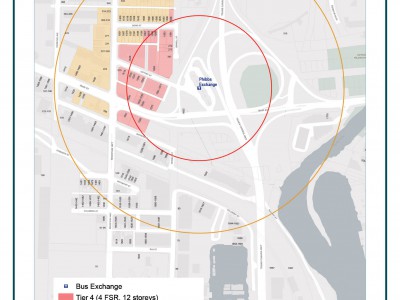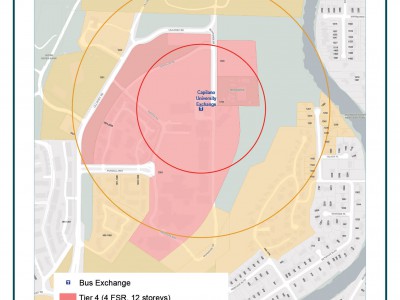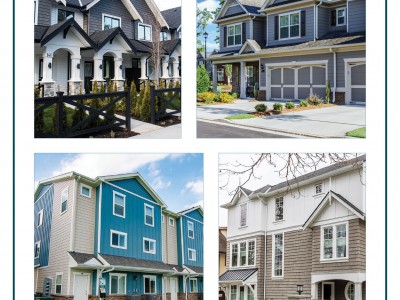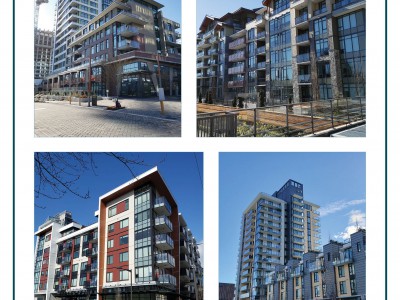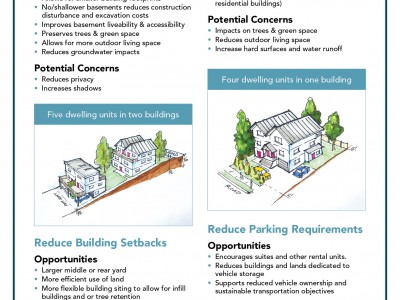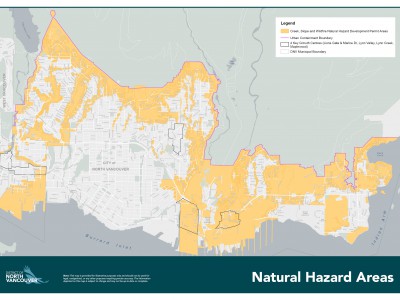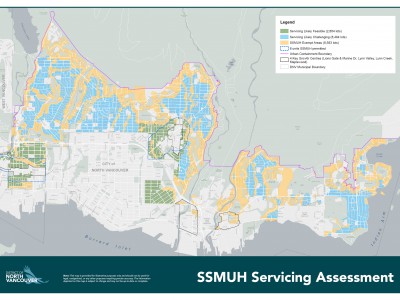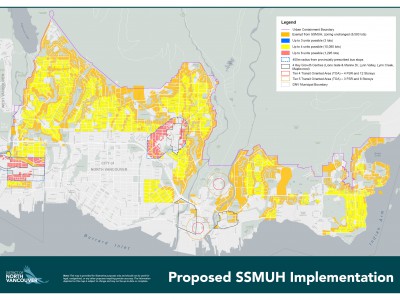New provincial housing legislation
In November 2023, the provincial government passed legislation intended to increase housing supply and improve affordability in all B.C. municipalities.
To achieve this goal, the B.C. government has made changes to allow more homes and offer different types of housing across the province.
How the changes will affect the District
The new legislation fundamentally changes how the District – and all local governments in B.C. – plans, considers and approves development and growth across our entire community.
These rules require the District to enable increased density in neighbourhoods traditionally zoned for detached single-family homes and duplexes. This increase in density also requires updates to strategic, long-term visioning for our community and to the municipality’s zoning bylaws.
The province requires that all relevant bylaws must be updated by June 30, 2024.
Key facts
- In most single-family neighbourhoods, the legislation supports up to three or four units per lot. In single-family neighbourhoods near frequent transit service, this could be as many as six units per lot.
- The provincial government has designated Transit Oriented Development Areas with minimum densities and heights near Phibbs Exchange and Capilano University.
- As part of the new rules, municipalities are no longer allowed to hold public hearings for residential projects that conform to the District’s Official Community Plan.
- The District’s Housing Needs Report must be updated by December 2024.
- The District's Official Community Plan and Zoning Bylaw must be updated by December 2025 to accommodate 20 years of projected residential growth.
Questions or comments?
Contact us to learn more or ask questions about the new provincial housing legislation.
News & updates
April 29, 2024 - Public input
Five public information meetings were held both in-person and online between April 10 and 23.
Did you miss the public information meetings? You can still watch a recording of the presentation and share your thoughts. The survey is now closed. Thank you for your input.
Overview
Below is an overview of new provincial housing legislation and details about how the new rules will affect the District.
Bill 44 Housing Statutes (Residential Development) Amendment Act
Mandates that traditional, single-family and duplex zones be replaced by Small Scale Multi-Unit Housing zones by June 30, 2024. These new requirements will typically allow larger and taller buildings with up to four units, and up to six units if located close to frequent transit.
The province has made exceptions to the new rules for lots that are outside the urban containment boundary, had heritage designation at the time the Bill gained Royal Assent in November 2023, properties that are un-serviced, large lots (over an acre), and certain lands subject to hazardous conditions.
The new rules mean that:
- Single-family homes will still be allowed, in addition to multi-unit housing with increased density
- The District of North Vancouver (DNV) is no longer able to require off-street parking for six-unit developments
- The DNV can no longer hold Public Hearings for residential development applications that meet the requirements under the new rules (Public Hearings are still optional for other types of rezonings such as commercial, industrial, institutional uses, unless there is an OCP amendment.)
- The DNV must prepare a Housing Needs Report by Dec. 31, 2024, and the Official Community Plan (OCP) and Zoning Bylaw must be amended by Dec. 31, 2025, to align with the Housing Needs Report and permit 20-years of future residential growth. The OCP must now also be updated every five years – a rolling plan.
Read more about Bill 44 on the provincial government website
Bill 46 Housing Statutes (Development Financing) Amendment Act
Provides new development finance tools for local governments to help fund the costs of infrastructure, amenities and services, such as water, sewers, transportation network improvements, community centres and daycares.
The legislation provides municipalities with amended Development Cost Charge powers. In addition to municipal utility, road and parks development cost charges, the DNV can now charge developers growth-related capital charges for new or expanded Police and Fire facilities.
New Amenity Cost Charge (ACC) powers allow the DNV to collect money from developers for other types of growth-related amenities, such as public art, daycares, and enhanced public areas. These charges are applied at the time of subdivision or building permit issuance, rather than being negotiated at the time of rezoning. ACC charges may be waived for affordable housing projects (just like DCC waivers).
Read more about Bill 46 on the provincial government website
Bill 47 Housing Statutes (Transit-Oriented Areas) Amendment Act
Changes the rules for the development in areas adjacent to major transit hubs, called Transit-Oriented Areas (TOAs), requiring local governments to allow new minimum heights and densities. In the DNV, the two TOAs are located at Phibbs Bus Exchange and Capilano University Bus Exchange.
- Within 200 metres of a major transit hub, the minimum allowable height is 12 storeys
- Between 200 and 400 metres of a major transit hub, the minimum allowable height is eight storeys
- The new rules require local governments to designate these areas by June 30, 2024
- With the exception of accessible parking, local governments can no longer require off-street parking for residential use in these areas. Parking standards for voluntarily provided residential parking (e.g. paving of parking areas) can still be required. Local governments can still require off-street parking for non-residential uses.
Read more about Bill 47 on the provincial government website
Local context
In the District, municipal road and utility services were constructed based on engineering standards of the day and did not account for the capacity needs of small-scale multi-unit housing or the current transportation and environmental objectives. While some areas of the District are well-positioned to service small-scale multi-unit housing and even denser housing forms, not all areas are.
Development in our community has been carefully planned and taking into account our Official Community Plan (OCP), geographic constraints, transportation limitations, and the surrounding natural environment.
Increased demand for housing has been a driving force behind Council initiatives that sought community input, such as approving infill housing where appropriate with units like secondary suites and coach houses. This approach to infill housing enabled us to add density to our single-family neighbourhoods without dramatically changing the neighbourhood’s character, which residents told us was important.
Of course, while the District has added more homes to the community, the whole region has grown. On the North Shore, many infrastructure elements – bridges, roads, parks, and schools, for example – have been challenged to keep pace with this growth.
The multi-layered challenge before us is how to increase the number of homes to address the housing demands in our region as now mandated by law in BC given our local context.
Path forward
The province has announced it is looking to add 230,000 new housing units throughout B.C.
Based on our proportion of the province’s population, that translates to building roughly 2,300 new SSMUH units and 1,800 new TOA units, respectively, over the next 10 years.
Between the housing units mandated to be added in the TOAs and in these areas where we want to see small-scale, four- to six-unit buildings added, we expect that we can reach the province’s stated targets, while concentrating the growth in areas where we know increased density makes most sense and already meets with community expectations, such as in and around existing Town Centres.
While our work has shown that we can address the immediate number of units mandated by the Province, we continue to work towards balancing the goals of the legislation, our OCP and community goals, and varying resident perspectives – with respect to where growth and various housing types make sense in our community.
Exemptions as allowed by the Province
Not all single-family properties will be eligible for increased density under the legislation. The provincial legislation has permitted the following exceptions to the application of Small Scale Multi Unit Housing Zones in residential areas:
- Lots larger than one acre
- Certain heritage designations
- Lots that are currently unserviced
- Lots outside the Urban Containment Boundary
- And lots that may be limited by some hazardous conditions
Many of these exemptions are relevant to the District at some level, but the most significant are the properties that are limited by hazardous conditions.
Mitigating community risk
The District has a long history of assessing natural hazards and mitigating risk to the community, such as constructing debris flow barriers to protect vulnerable areas, and through careful consideration how and where development is done through our Development Permit Areas (DPAs).
The intent of DPAs is to protect people in our community from hazardous conditions in areas that may have a heightened level of susceptibility, and these are outlined in our current OCP.
Three of these hazard DPAs in particular – wildfire hazards, creek hazards, and slope hazards – are relevant to the discussion of adding more density, and more people, to areas already defined as high risk.
Therefore, in reviewing the requirements under Bill 44 for small-scale multi-family housing (SSMUH), and the permissible exemptions from the Province, we are recommending the land parcels currently subject to one or more of the three DPAs in place for natural hazards also be identified as our exempted land parcels to SSMUH.
While we are working hard to address the housing shortage, the District must also consider the known risks as understood through our hazard assessment work. Considering the tight timelines mandated by the Province, we need to use the information we have at hand to make decisions that supports public safety.
Our work to assess and monitor natural hazards will continue as conditions change and we learn more about the risks and impacts within the context of the future vision of our community. As our understanding of the risks evolves, so will the application of exemptions we attribute to certain land parcels.
Next steps
The District is committed to doing our part to help address the provincial housing situation. These sweeping changes mandated by the Province need to be endorsed by Council through new zoning bylaws by June 30, 2024.
Other key dates include:
- Complete interim Housing Needs Report by December 31, 2024
- Complete updates to the OCP and zoning bylaws by December 31, 2025
Documents & links
Fact sheets
Presentations
View the slides from the public information session presentation.
Information boards
View the presentation boards from our recent public meetings.
Download the three maps in this presentation as a PDF document
Get information about your property
View your property information on GEOweb Property Viewer, including the proposed zoning for small-scale multi-unit housing.
Council reports
- April 2, 2024 — Staff report to Council
- February 12, 2024 — Staff report to Council
Q&A
Find answers to questions posed by residents about the new provincial housing legislation.
Please note, the responses to these questions are based on our current understanding. These responses should not be taken as legal advice as the information may be incomplete and subject to change.
Bylaw process
Question: When will the draft bylaws available for the public?
Answer: Draft bylaws will be made available through their introduction to Council, which is anticipated to occur in early June. Bylaw adoption must occur by the deadline set out in provincial regulations, June 30th, 2024.
Q: Where can we view the maps for the rezoning and how can I find out what proposed zoning my property is in or if it is in an exclusions zone? Will these detailed plans be available for us to review for specific properties?
A: The presentations and display boards from the public information sessions are available on the website. Property owners can also search for specific properties on the District’s GEOweb tool where proposed zoning is listed under the “Property Information, Regulatory” tab.
Q: Can you confirm that application under this law change won’t be considered until 2026?
A: Applications to develop under new SSMUH zoning regulations can be submitted once the new bylaws are adopted by Council. A process for enquiries and applications will be made available following June 30th, 2024.
Q: Is there a zoning guideline we can download now? Also is there a step code level requirement?
A: Zoning guidelines or information handouts are not currently available but will be developed as soon as possible following June 30th, 2024, the mandated date by which time SSMUH bylaw adoption must occur. As of November 1, 2023, all Part 9 residential buildings (e.g., single family home, coach house, smaller townhouse) are required to meet Step 5 or Step 4 and Emissions Level 3, and all Part 3 residential buildings (e.g., larger multi-family and apartment projects) are required to meet Step 4 or Step 3 and Emissions Level 3. Find details: District of North Vancouver’s Energy Step Code and Zero Carbon Step Code
Q: Given the housing shortage crisis, what are the District’s plans to deal with pre-zoning large lots which are exempted from the new multi-family zoning? Some of these lots are within a short distance of the designated town centres and are transit-oriented
A: In addition to the requirements to adopt a bylaw designating TOAs and Zoning Bylaw amendments to permit SSMUH, Bill 44 also requires the District to complete an interim Housing Needs Report by December 31, 2024, and update the OCP and Zoning Bylaw to align with the interim Housing Needs Report prior to December 31, 2025. These next phases of planning work offer opportunities to engage with the community on land use changes that would support achieving the District’s housing targets.
Q: When/what timeline do you anticipate the first set of applications might be taken in under the new provincial timelines? When can one start developing a property according to these new changes?
A: Applications to develop under new SSMUH zoning regulations can be submitted once the new bylaws are adopted by Council. A process for enquiries and applications will be made available following June 30th, 2024.
Q: When will the new bylaws allowing a basement suite and a coach house on a single-family lot be finalized and adopted?
A: Applications to develop under new SSMUH zoning regulations can be submitted once the new bylaws are adopted by Council. A process for enquiries and applications will be made available following June 30th, 2024.
Q: For current owners who have crawl space area available to increase square footage to create rentals? Will this be looked at?
A: Inquiries to convert existing crawlspaces into a finished rental space may be made by emailing building@dnv.org or calling the building department at 604-990-2480.
Q: Assume one owns a small home with a secondary suite. Can this be torn down and simply replaced with a larger version of of the same thing - ie. 2 units only OR is one forced to put more units on the property?
A: Yes, an existing house with a secondary suite can be replaced with a new house that also contains a secondary suite. Any maximum number of dwelling units permitted by a new SSMUH zone is expected to be just that, a maximum and not a requirement.
Q: Will the new legislation lead to changes to laneway housing rules? Will larger laneway houses be permitted?
A: Coach houses and similar infill residential buildings are being considered under the new SSMUH zone. The specific regulations, including maximum floor areas, will be proposed to District Council through the introduction of the new zoning bylaw, which is expected to occur in early June.
Q: Is there a way DNV willing to work with developers in perhaps fewer units instead of four to kick start construction instead of waiting for dates that are unknown for go ahead?
A: Developers are welcome to submit building permit applications under current zoning. For those seeking to develop under the new SSMUH zoning regulations, applications must wait for the Zoning Bylaw amendments to be adopted by Council, which will before June 30, 2024.
Environmental Protection
Q: Did the Province include any environmental studies/review to be done on a case-by-case basis? I am thinking of all the single-family homes in the DNV upon which lots have many trees, and what will happen to these and what could long term effects be?
A:To the District’s understanding, the Province did not complete any environmental studies or reviews prior to mandating land use change through the new SSMUH legislation, nor did they require or request the District to do so. The urban tree canopy is a topic of interest to both Council and the public. SSMUH zoning is being developed to consider tree retention and/ or replacement that will include a review of the Tree Protection Bylaw.
Exemption Zones
Q: Can a property owner of an exempted property apply for increased density? Will property owners have the ability to demonstrate with consultants and professionals the ability to mitigate a risk and still apply for SSMUH?
A: The District will have a process for enquiries about exempt lots and will make that information available following bylaw adoption.
Q: Are "natural hazard areas" lots going to be excluded for SSMUH rezoning?
A: Yes. Lots within natural hazard areas are proposed to be excluded from any new SSMUH zone.
Q: Are the exempt areas proposed or have they been approved by the province?
A: The exemptions have been proposed by staff. Proposed exemptions will be presented for Council’s consideration when adopting SSMUH zones, prior to June 30th, 2024. Bill 44 does not require Provincial approval of exempt areas, only that exemptions comply with the regulations and that the Province is notified of the exemptions in a timely manner.
Q: Why are 1-acre properties exempt?
A: In its SSMUH Policy Manual & Site Standards document the Province states that Lots equal to or greater than 4,050 m2 are exempt from the requirements to permit a minimum of 3 or 4 units due to their potential for subdivision and higher densities in urban and sub-urban contexts.
Q: The application of hazards exemption does not seem fair as one side of a street has options while the other side is exempt. Why can this not be done according to existing zoning?
A: The recent provincial legislation defines where SSMUH zoning will not apply, which includes lands that are subject to hazardous conditions. The District has three Development Permit Areas (DPAs) that document known wildfire, creek (flood) and slope hazards. These DPAs designations are based on extensive technical assessment and studies. Due to our current understanding and time limitations, the District’s wildfire, creek and hazard DPAs have been used to identify property exemptions. Staff expect however to seek guidance from Council on undertaking further detailed neighbourhood-level or community-wide assessments in the coming months/years to refine hazardous area exemptions in response to new information and changing conditions.
Q: Why are some lots in areas such as Upper Lynn Valley restricted from new multi-unit zoning based on fire safety concerns when there are already townhouses/multi unit developments backing onto the same areas?
A: Provincial legislation has required the District consider the presence of hazards relative to future, not past development approvals. Exemptions have therefore been made based on the District's current understanding of hazards that are identified through Development Permit Areas.
Floor Space Ratio (FSR)
Q: What will the new FSR requirements be for a lot eligible for 4 housing units?
A: The province recommends local governments carefully consider whether FSR limits are necessary to regulate density in SSMUH zoning. FSR requirements and considerations for SSMUH zoned lots will be proposed to District Council through the introduction of new zoning bylaws, which are expected to occur in early June.
Q: Is the new FSR going to be 1.5 including/excluding basement? Will DNV allow underground parkade? Will this be included in the FSR?
A: The province recommends local governments carefully consider whether FSR limits are necessary to regulate density in SSMUH zoning. FSR requirements and considerations for SSMUH zoned lots will be proposed to District Council through the introduction of new zoning bylaws, which are expected to occur in early June.
Q: Are there any anticipated changes to allowable FSR for single family projects in SSMUH applicable areas? Will there be any reductions to allowable FSR for this type of development?
A: The province recommends local governments carefully consider whether FSR limits are necessary to regulate density in SSMUH zoning. FSR requirements and considerations for SSMUH zoned lots will be proposed to District Council through the introduction of new zoning bylaws, which are expected to occur in early June.
Q: A publication prepared for the Ministry of Housing - SSMUH and TOA Scenarios in British Columbia Dec 6, 2023 - clearly indicated that the MINIMUM FSR for SSMUH be set to 1.5. Can you comment on this critical element?
A: The site standards contained in the provincial policy manual do not include minimum FSR recommendations. The province recommends local governments carefully consider whether FSR limits are necessary to regulate density in SSMUH zoning. FSR requirements and considerations for SSMUH zoned lots will be proposed to District Council through the introduction of new zoning bylaws.
Q: When will questions about FSR be answered?
A: The province recommends local governments carefully consider whether FSR limits are necessary to regulate density in SSMUH zoning. FSR requirements and considerations for SSMUH zoned lots will be proposed to District Council through the introduction of new zoning bylaws, which are expected to occur in early June.
Form and Character
Q: With the density increase can small separate dwellings be built on a single-family lot? Are revised/relaxed setbacks being considered to accommodate the higher density?
A: The intent of the bylaw changes is to create flexibility. Provincial guidelines suggest smaller setbacks on all sides and accommodating more than one residential building on a lot.
Q: Will there be a benefit to the homeowner to build something that is architecturally appealing?
A: The District’s primary focus at this time is to amend single family zoning in compliance with Bill 44 while considering Official Community Plan objectives, and as such, this question cannot be answered at this time.
Q: Will viewscapes be considered? I have views of the mountains but if a three-storey building is built in front of my house my view will be impacted.
A: Local governments are prohibited from using their zoning powers to unreasonably prohibit or restrict the use or density required to be permitted under the legislation. To achieve the required density while ensuring project viability, preserving site permeability, and achieving unit liveability, it is necessary to permit up to 3-storeys. Over time as lots develop under SSMUH zoning, views from some existing properties may be impacted.
Green space and vegetation
Q: The district has quite loose controls over tree removal compared to other urban municipalities. Will these be improved to ensure we do not lose all trees in the current single-family neighbourhoods.
A: The urban tree canopy is a topic of interest to both Council and the public. SSMUH zoning is being developed to consider tree retention and or replacement that will include a review of the Tree Protection Bylaw.
Heritage designations
Q: What “certain heritage designations” qualify for exemptions from SSMUH? Do properties on the Heritage Register apply?
A: There are two exemptions from SSMUH related to heritage conservation: 1) properties protected under s.12.1(2) of the Heritage Conservation Act (HCA), and 2) properties subject to a heritage designation bylaw per s.611 of the Local Government Act (LGA) as of December 7, 2023. Properties on the Heritage Register alone are not exempt from SSMUH requirements.
Q: Can new heritage site designation of existing homes be done in the future?
A: The SSMUH legislation does not remove the protective tools for heritage conservation within the Local Government Act (LGA). Heritage tools available to local governments including heritage registrations and designations, heritage revitalizations agreements (HRAs), and heritage conservation areas can still be used to encourage and support heritage conservation. However, local governments cannot use heritage designation bylaws or heritage revitalization agreements to prevent SSMUH densities (except those entered into before December 7, 2023) . Additionally, local governments cannot use heritage alteration permits or designation of heritage alteration permits to unreasonably restrict the use and density permitted under SSMUH. Staff will be exploring ways to continue to encourage and support heritage conservation in the District.
Official Community Plan
Q: What options are open to council on the OCP review by June 30, 2024?
A: The Province has required that municipalities update their OCP’s by Dec 31st, 2025, which the District will abide by.
Parking
Q: What are proposed parking requirements for 4 unit lots?
A: Provincial guidance is 0.5 to 1 space per unit.
Q: What are proposed parking requirements for 6 unit lots? And are laneway or flanking streets required?
A: Local governments are prohibited from requiring off-street parking for lots that must permit up to 6 units. Developers can provide parking voluntarily and any parking spaces provided would be subject to District design standards. Lots that permit up to 6 units are not required to have lanes or flanking streets.
Q: Will 4- or 6-unit builds be able to construct underground parking with basements from lot line to line just like typical townhouse or condo developments have?
A: The province has not provided specific guidance on underground parking. The District is preparing bylaws that balance all Official Community Plan objectives in what are currently single-family neighborhoods, such as protecting trees and groundwater that may conflict with the provision of underground parking.
Q: How do you address impacts to street parking?
A: The District will consider how to manage increased demand for street parking through parking requirements or resident parking permit systems in the areas with SSMUH zoning. [KD1]
[KD1]Pulled from Dan’s answers.
Servicing
Q: Are "servicing likely feasible" lots going to be approved before/earlier or more easily than "servicing likely challenging" lots?
A: The feasibility of lot servicing is being reviewed. More analysis of District infrastructure is required before the District can confirm its ability to service any lot, set servicing requirements for individual lots or determine the timing of any potential development approvals.
Q: Can property owners in “servicing likely challenging” areas apply for a 4-unit zoning after the bylaw comes into effect?
A: The District will have a process for inquiries and applications and will make that information available following June 30th, 2024.
Q: How can property owners understand which properties have services that are “likely challenging”?
A: The feasibility of lot servicing is being reviewed. More analysis of District infrastructure is required before the District can confirm its ability to service any lot or set servicing requirements for individual lots. The District is not able, at this time, to model any lot on an individual basis.
Q: When will the District be completing or updating its assessment on how this change in density will impact capacity for other community services (i.e. school & healthcare capacity, road and traffic, etc.) and when will the DNV be able to share this with the public?
A: The District will be taking a holistic approach on how to meet all servicing needs as part of its upcoming Official Community Plan (OCP) update, which will involve understanding demands on schools, healthcare facilities, and infrastructure.
Q: For lots located in blue (service challenged areas) will the developer's [be able to make a] monetary contribution to upgrade the service to enable SSMUH?
A: SSMUH servicing requirements and implementation strategies are in the process of being established and will be communicated as soon as practically possible after bylaw adoption is approved. The determination of upgrades will likely require a detailed site-level analysis as part of a formal development application.
Q: Considering the numerous delays in completion, do we have the sewage capacity in order to add as many properties as this presentation proposes? How will water/sewers upgrades be financed?
A: The District will be reviewing technical and financial strategies to upgrade DNV-owned infrastructure as part of its ongoing financial planning work and the upcoming Official Community Plan (OCP) update.
Q: How is the extra water demand and sewage generation going to be managed? Would infrastructure (sewers, water pipes etc.) not have to be expanded before such developments could go ahead?
A: The feasibility of lot servicing is being reviewed. More analysis of District infrastructure is required before the District can confirm its ability to service any lot, set servicing requirements for individual lots or determine the timing of any potential development approvals.
Storm water management
Q: Can District apply additional building guidelines related to storm water management?
A: The District has the ability to apply existing and create additional storm water management standards to SSMUH development applications, which is being considered through our review and implementation of the new provincial legislation.
Q: How will the District manage the increase in impermeable space and the additional stress on our stormwater systems (i.e. creeks)?
A: The District has the ability to apply existing and create additional storm water management standards to SSMUH development applications, which is being considered through our review and implementation of the new provincial legislation.
Q: A plan to disperse stormwater runoff into the ground requires permeable unsaturated soil. Where on the North Shore (if anywhere) would have such soil conditions?
A: A wide range of soil conditions occur across the District, with varying permeability. Stormwater (drainage) plans for proposed redevelopment require site specific data to meet local ground conditions and access to storm sewers or other drainage infrastructure.
Tenure (Rental and Strata)
Q: Will there be incentives for rental housing?
A: The District is aware of the need for rental housing within the community and is considering how this may be addressed through SSMUH zoning and other policy updates.
Q: Will strata units be allowed?
A: The District is considering how and where stratification of SSMUH developments may be permitted. Staff recommendations will be presented to District Council through the introduction of new zoning bylaws, which are expected to occur in early June.
Q: These changes may increase supply of housing, but will they address affordability? What are the possible ownership structures for the future multi-unit properties.
A: The province considers that the creation of small-scale multi-unit housing will provide affordability by increasing housing supply and diversity. The impact of the new SSMUH zones on general housing supply and affordability is yet to be determined. The District is considering how stratification and rental tenure of SSMUH developments should be permitted. Staff recommendations will be presented to District Council through the introduction of new zoning bylaws, which are expected to occur in early June.
Q: Will council decide about strata for SSMUH by June 30 as well?
A: The District is considering how and where stratification of SSMUH developments may be permitted. Staff recommendations will be presented to District Council through the introduction of new zoning bylaws, which are expected to occur in early June.
Q: Does three units essentially mean stratified units or, does a single-family home that is limited to a main house, basement and a coach home equal 3 units?
A: Yes, a single-family home, secondary suite, and a coach house would be considered three separate dwelling units. From a regulatory perspective, a secondary suite, located in a single-family home or other building type where secondary suites are permitted, cannot be stratified under the BC Building Code.
Q: How would rental tenure bylaws influence developers’ motivation for building SSMUH housing projects?
A: The province considers that the creation of small-scale multi-unit housing will provide increased housing supply and diversity. The impact of the new SSMUH zones on general housing supply is yet to be determined. The District is considering how stratification and rental tenure of SSMUH developments should be permitted. Staff recommendations will be presented to District Council through the introduction of new zoning bylaws, which are expected to occur in early June.
Q: How do all of these changes affect lease hold properties in the same way as other properties, such as in the Cedar Village area around the Lynn Valley high density area?
A: Cedar Village is located within the City of North Vancouver, and as such this questions should be directed towards the City of North Vancouver. 2020 Cedar Village Cresent, located within the District of North Vancouver, is a multi-family building to which new SSMUH legislation does not apply.
Q: How are short term rental rules going to be managed? Someone could build 4-6 units and simply rent them out through Airbnb and it would be difficult to tell.
A: District Council considered a proposed regulatory framework and associated bylaw amendments for short-term rentals in March 2024. Staff were directed to report back to Council after provincial short-term regulations came into effect (May 1, 2024) and once new SSMUH zoning has been adopted by Council. Staff are targeting Fall 2024 for an update to Council.
Q: Doesn’t restricting stratification reduce affordability? In our area, most wealth is through real estate ownership, doesn’t stratification help?
A: The province considers that the creation of small-scale multi-unit housing will provide affordability by increasing housing supply and diversity. The impact of the new SSMUH zones on general housing supply and affordability is yet to be determined. The District is considering how stratification and rental tenure of SSMUH developments should be permitted. Staff recommendations will be presented to District Council through the introduction of new zoning bylaws, which are expected to occur in early June.
Transportation and Traffic
Q: We are already at gridlock or slow traffic at peak times. What will be the impact on mobility and journey times?
A: Staff expect to evaluate the potential impacts of provincial housing policy changes, including resident mobility and journey times, on the District’s transportation infrastructure as part of a holistic update to the District’s Transportation Plan. This work is expected to be conducted in parallel to the District’s Official Community Plan update that is scheduled for completion by December 31st, 2025.
Q: What are the next steps to update the transportation plan or other service upgrades that would be needed to accommodate the increased population growth?
A: Staff expect to evaluate the potential impacts of provincial housing policy changes, including resident mobility and journey times, on the District’s transportation infrastructure as part of a holistic update to the District’s Transportation Plan. This work is expected to be conducted in parallel to the District’s Official Community Plan update that is scheduled for completion by December 31st, 2025.
Transit-Oriented Areas
Q: The province has expanded the definition of TOA to include bus stops, which bus stops are going to be included in the District rezoning?
A: The Province has not expanded the definition of TOAs to include bus stops. Bus stops used to designate potential 6-unit SSMUHs along "frequent transit" corridors remain unchanged from those presented at the engagement presentations, specifically the areas shown in the maps along Marine Drive and in Lynn Valley Town Centre.
Q: The Transit Oriented Area designation for Capilano University doesn’t make sense.
A: The Province has defined TOA locations by regulation and made no attempt to identify or address District concerns.
Q: How close in proximity to "frequent transit" for 15-minute intervals on Saturdays from 10am to 6pm in order to qualify for 6 units?
A: In order to permit up to 6 units, a lot has to not be exempt from SSMUH and be within 400m of a Prescribed Bus Stop as defined by the provincial regulations.
Q: Given the intent to provide more housing around transit nodes, will the District look to allow potentially more density above the designated minimums on the remaining sites so to provide the housing the TOA designated intended?
A: Density above the designated minimums will likely not be included in the bylaws. This is a topic that is more applicable to a future OCP amendment.
Q: Why are there not more areas identified as frequent transit? It seems to be that many more bus stops in the District should apply based on the Province’s rules of (a) at least every 15 minutes, on average, between the hours of 7 a.m. and 7 p.m., Monday to Friday; (b) at least every 15 minutes, on average, between the hours of 10 a.m. and 6 p.m. on Saturdays and Sundays.
A: The definition for a prescribed bus stop can be found in the Provincial Policy Manual & Site Standards for Small-Scale, Multi-Unit Housing, on page 9. Of note, the frequency threshold set by the Province must be achieved by one bus route, not through a combination of multiple bus routes.
Q: In the Cap U TOA, will a developer need to submit a rezoning application after this new zoning is implemented?
A: The District will be designating TOA areas prior to June 30th but not changing zoning.
Q: Are there any right of ways planned for future rapid transit (i.e. Skytrain)?
A: The District continues to work with TransLink to plan for future rapid transit investments in the District and across the North Shore, including advancing the business case development for the ultimate technology (e.g., Bus Rapid Transit, Light Rail Transit, or SkyTrain) and to confirm the alignment and station locations.
General
Q: Can our citizens say "NO" to the province?
A: The bills related to the provincial housing changes have already received Royal Ascent and are now law for those Municipalities that have been required to comply.
Q: If there is low uptake on the SSMUH (likely due to financial risk/non-feasibility) could the housing targets theoretically be met by focusing on the four existing designated town centre areas?
A: Yes, that is theoretically possible.
Q: What is the time frame for the 130,000 additional units across BC?
A: The province’s preliminary modeling estimated that the province could see approximately 100,000 new units in Transit Oriented Areas (TOAs) and 130,000 new Small-Scale Multi-Unit (SSMUH) homes in B.C. within the next 10 years.
Q: Why isn’t the District holding a referendum on this?
A: The bills related to the provincial housing changes have already received Royal Ascent and are now law for those Municipalities that have been required to comply.
Q: It’s becoming clear that the housing crisis was made considerably worse by the federal government decisions to increase demand with large increases in immigration, temporary foreign workers & international students. These numbers are being reduced again to more manageable historic levels. Wouldn’t it be prudent to wait until the dust settles on finding the manageable level of immigration before making these big changes to housing development processes?
A: The bills related to the provincial housing changes have already received Royal Ascent and are now law in BC. The District must comply within the timelines identified.
Q: What is planned for hiring people to avoid the potential for a huge backlog of permits etc.?
A: Building permit applications of all types are influenced by many factors. As Council responds to the new SSMUH legislation it will be determined how many additional staff may be needed to respond to all future permits to achieve acceptable service levels.
Q: My understanding is the province is threatening to withhold provincial funding if municipalities don’t capitulate. That implies there is a choice. Is that not correct?
A: We haven’t heard this in conversations with the province. The expectation is these changes will occur. The province can impose the change and approve the bylaws that are required under that legislation.
Q: If a lot's zoning changes (to, e.g. 6 units), would that lead to a drastic increase in the property value, and, therefore, property taxes?
A: The province has indicated that they will review future property sales relating to small scale multi-unit housing changes and then adapt the annual assessment in response to those purchases. However, the potential impacts on property taxes are unknown
Q: A provincial publication "Provincial Policy Manual & Site Standards" contains a wealth of information. It is a MUST READ document for Council as indicated on page 1 (Introduction). Could this, and such documents, be made more known to the public?
A: Links to the provincial housing initiatives webpage, which includes the "Provincial Policy Manual & Site Standards," is referenced on the District’s dedicated webpage for the new provincial housing legislation.
Q: Regarding possible loss of CAC revenue, DNV needs to remind property owners that we enjoy some of the lowest property tax rates in North America. We should be paying more.
A: The District is in the process of creating a new Amenity Cost Charge that will replace CAC revenues, in consideration with new Provincial Legislation.
Q: Can I simply replace my home with a more modern version?
A: Yes, it will be possible under the new zoning for an existing single-family dwelling to be replaced with a new single-family dwelling. Property owners can choose to build fewer than the maximum number of units permitted under the new SSMUH zoning.
Q: If possible, can zero lot line developments be acceptable?
A: The Provincial Policy Manual & Site Standards suggest that zero lot line side yard setback can be considered for lots that must allow up to 6-units and that are located in urban settings where the desire is to achieve row housing type units. Setback requirements for SSMUH zoned lots will be proposed to District Council through the introduction of new zoning bylaws, which are expected to occur in early June.
Q: Will pad mounted transformers be required for 4 unit lots?
A: BC Hydro will determine electrical transformer requirements that we expect will be based on individual applications made to them. The Distict’sDistrict’s current practice is that pad mounted transformers are located within the property boundaries of multi family developments.
